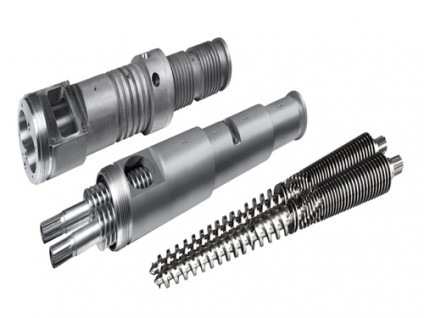In today's highly competitive global market, plastic processors can gain an advantage by incorporating relatively simple practices into their operations. In Injection Molding Screw Barrel , extrusion or blow molding, the plasticizing device is the key to production efficiency and final product quality. The main components of the plasticizing device, namely the feeding screw and barrel, should be designed to provide maximum melting efficiency at the original gap between the inner diameter of the barrel wall and the outer diameter of the screw thread. These gaps are usually small (0.001 inches per side, per inch diameter) to achieve good heat transfer and shear rates.
Once the screw starts to rotate in the Single Screw Extruder Screw Barrel, wear begins. Wear may occur on the screw threads or the surface of the barrel, or both. The harder the processed material, whether it is the abrasive filler in the processed polymer or the "mixed" metal particles that are not part of the melt flow, the faster the abrasion and the increase in the original gap. As the gap increases, the melting efficiency will decrease. Due to the reduced melting efficiency at the original setting, many operators tend to compensate by increasing the screw speed, adjusting the barrel temperature, increasing the back pressure, or some combination of these adjustments.
Adjustments are operators trying to avoid longer cycles, unmelted materials, higher melting temperatures, or higher scrap rates. Usually, these changes are gradual and will not be noticed until they significantly affect part quality or productivity.
The impact of screw wear on plastics
Once the screw starts to rotate in the barrel, the screw threads or the surface of the barrel or both will begin to wear. As the melting efficiency at the initial setting decreases, many operators tend to make adjustments to avoid longer cycles, unmelted materials, higher melting temperatures, or higher scrap rates. Usually these changes are gradual and will not be noticed until they significantly affect part quality or productivity.
When the plasticization rate, productivity (whether in pounds per hour or parts), or reject rates reach unacceptable levels, process engineers may begin to look for reasons. Unfortunately, it may not be possible to repair quickly at this time unless there are spare screws or barrels around. If replacement parts are available, they can be replaced in about a day. Otherwise, the production line will have to shut down or run at reduced efficiency until replacement parts are found and installed.
Types and causes of wear
So how to avoid this dilemma? Let's start by identifying the three types of wear.
1. Adhesive wear. This happens when the metal surface (the propeller plate and the inner surface of the barrel) is in contact. When the surfaces briefly touch and weld together, and then break, extremely high stresses are generated. Evidence of adhesive wear may be a burr or "rolling" on the rear edge of the tail, or a scratch or missing of the hard surface material on the top of the tail. Also check the inner diameter of the barrel for scratches or wear. The damage on the screw is located in the barrel.
Adhesive wear is the adhesive wear of plastic processing screws when the metal surface (screw thread surface and the inner surface of the barrel) contact.
2. Abrasive wear. This is probably the most common type of wear in plastic machinery. In the case of handling unfilled or low viscosity polymers, it can be minimal. When the particles are transported down the screw and pressed on the barrel wall, the shearing action will cause a certain degree of wear on the screw thread and barrel wall. When processing resins with fillers, additives, or contaminants in recycled materials, or even when processing high-viscosity polymers, abrasive wear can become severe. Hard materials tend to remove material from softer surfaces. For this reason, wear-resistant alloys are commonly used for surface hardening during flight landings. Before the additives are wetted and mixed with the molten plastic, glass and mineral-filled resins can also cause wear at the screw root, usually at the back of the channel.
Abrasive wear in plastic processing screws When particles are transported down the screw and pressed on the barrel wall, the shearing action will cause a certain degree of abrasive wear on the screw threads and barrel wall.
3. Corrosion and wear. Corrosion is the gradual destruction of materials by chemical attack. Most of the atoms on the same metal surface are oxidized, destroying the entire surface. Cracking of the metal surface actually makes the surface vulnerable to mechanical wear mechanisms. Corrosion is the most common when processing polymers in the PVC or fluoropolymer series and can severely attack components with high-iron matrix.
Corrosion in screws Wear corrosion is the gradual destruction of materials by chemical attack.
https://www.screwbarrel.co/screw-barrel-for-injection-machines/screw-barrel-for-injection-molding.html








